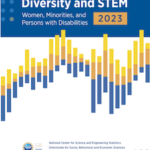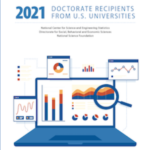 All Entries in the "Gender Gap" Category
All Entries in the "Gender Gap" Category

A Persisting Gender Pay Gap in Teacher Compensation in the Public Schools
A new study by the Brookings Institution finds that although women make up roughly three–quarters of the teaching workforce, they make an estimated $5,000 less than men annually, Much of the gap is explained by men doing extra work – such as coaching – and being more likely to get paid for this extra work than women.

How Colleges and Universities Can Impact the Gender Gap in the Tech Workforce
A new study by Accenture, the consulting and technology services company based in Dublin, Ireland, has issued a new report that finds that the proportion of women to men in tech roles has declined over the past 35 years. And half of all young women who go into tech drop out by the age of 35.

Women Underrepresented Among “Super Principal Investigators” on NIH Grant Projects
Super principal investigators are researchers who received three or more concurrent grants from the National Institutes of Health. Women were significantly underrepresented among SPIs, even after adjusting for career stage and degree. Women were 26.6 percent of all super principal investigators in 2020. They were 34 percent less likely than their male colleagues to be an SPI.

College Athletic Powerhouses Receive a Grade of F in Gender Equity in Leadership Posts
In the Fall of 2022, there were 30 women who served as president or chancellor of the 130 educational institutions that make up the Football Bowl Subdivision of Division I of the National Collegiate Athletic Association. Women were only 7.7 percent of all directors of athletics at these colleges and universities

The Snail-Like Progress of Women Into the Executive Suite at the Nation’s Largest Companies
A new study by USA Today finds that of the 533 executive officers at the nation’s largest firms, there were 90 women. They made up 17 percent of the total. Women of color made up just one percent of all executive officers at these firms.

Women Making Progress in STEM Education and Occupations, But More Work Needs to Be Done
The number of science and engineering degrees earned by women between 2011 and 2020 increased by 63 percent at the associate’s level, 34 percent at the bachelor’s level, 45 percent at the master’s degree level, and 18 percent at the doctorate level. But in 2021 women, who were 51 percent of the population, represented about one-third of the STEM workforce.

Study Examines How an Academic Department’s Gender Composition Impacts Teacher Evaluations
A new study led by Oriana Aragón, an assistant professor of marketing in the College of Business at the University of Cincinnati, finds that professors in the gender minority of university academic departments tend to receive lower scores in their performance evaluations because of gender bias.

Women Make Up a Tiny Percentage of Editors of Scientific Journals
A new study led by researchers at New York University Abu Dhabi examined the gender disparity in the makeup of editorial boards of scientific journals. The researchers used algorithmic tools to infer the gender of 81,000 editors serving more than 1,000 journals and 15 disciplines over five decades. The results show that only 14 percent of the editors were women. Only 8 percent of editors-in-chief were women.

American Association of University Women Updates Its Report on the Gender Pay Gap
Using data from the U.S. Census Bureau and the U.S. Bureau of Labor Statistics, the AAUW calculated that in 2021 women were paid just 84 cents for every dollar paid to men when comparing full-time, year-round workers. However, when the calculation included all workers, the earnings discrepancy is substantially larger: Women took home only 77 cents for every dollar men did.

San Diego State University Scholar Finds Women Are Vastly Underrepresented in Behind-the-Scenes Roles in Hollywood
A study by Martha M. Lauzen, a professor and executive director of the Center for the Study of Women in Television and Film at San Diego State University, found that in 2022, women comprised 24 percent of directors, writers, producers, executive producers, editors, and cinematographers working on the top 250 grossing films. This represents a decline of 1 percentage point from 2021.

Gender Differences in Enrollments in Post-Pandemic Higher Education
In October 2021, there were 10,061,000 women enrolled in higher education in the United States. They made up 58.1 percent of all enrollments in higher education. Women were 58.3 percent of all students entering graduate school in the fall of 2021. They were 57.8 percent of all students in their second or more years in graduate school.

Workplace Fatalities for Women Increased Sharply in 2021
While women make up a low percentage of all work-related fatalities due to injuries, the number of deaths of women has been increasing. While women were just 8.6 percent of all work-related fatalities, they made up 14.5 percent of fatalities as a result of intentional injuries inflicted by a person in 2021.

Women Continue to Make Gains in Medical School Enrollments
The number of women first-year students at U.S. medical schools in 2022 increased slightly, to 12,630. Women made up 55.6 percent of all first-year students in U.S. medical schools. In 2022, there were 51,890 women students enrolled at U.S. medical schools. They made up 53.8 percent of all medical school students.

Women Make Up More Than Three Quarters of All Teachers in K-12 Schools
Overall, 76.6 percent of the nation’s teachers in K-12 schools are women. Women make up nearly 90 percent of all teachers in elementary schools. Women are 72.4 percent of middle school teachers and 59 percent of high school teachers.

Women to Continue to Make Progress Toward Equality at Leading Business Schools
The data shows that although overall enrollments in MBA programs are down, the number of women students increased in 2022. There are 17 leading business schools where women make up at least 45 percent of all enrollments. Leading the way are the business schools at Johns Hopkins University and the University of Pennsylvania, where women were 50 percent or more of all enrollments.

Gender Gap in Graduation Rates for Students Athletes on Scholarship
Three quarters of women students who entered college in 2013 between 2012 and 2015 with an athletic scholarship went on to earn their degree at the same educational institution within six years. Only 62 percent of men who entered college with an athletic scholarship in those years earned a bachelor’s degree by 2021 at the same institution.

Gender Differences in the Age of Doctoral Degree Recipients in the United States
In 2021, women were more likely to earn a doctorate at an older age. For example, 14.7 percent of all women who earned doctorates in 2021 were over the age of 40. For men earning doctorates in 2021, only 9.8 percent were over the age of 40.

Legislation Aims to Boost the Number of Women-Owned Firms Managing Higher Education Endowments
Women- and minority-owned asset management firms currently control only 1.4 percent of the over $82 trillion in managed assets in the United States compared to the 98.6 percent of assets controlled by firms owned by White men.

Study Finds Women Medical Students Publish Less Scholarly Research Than Their Male Peers
A new study led by Mytien Nguyen an M.D.-Ph.D. student at Yale School of Medicine found that there were only slight differences between men and women medical school students in research experiences. But women students had 10 percent fewer publications than their male peers.

The Significant Gender Gap in College Graduation Rates
The statistics show that 64.5 percent of all students entering four-year colleges in 2015 seeking a bachelor’s degree had graduated within six years. Some 66.4 percent of all women had earned a degree within six years compared to 60.4 percent of men. Women graduated at a higher rate than men in all racial and ethnic groups.

Is the Art Market Biased Against Works Created by Women?
A study led by researchers at the Yale School of Management notes that a large percentage of artworks sold at auction or displayed at major museums were created by men. But their research shows that for graduates of the Yale School of Art, the gender gap no longer exists.

Men Continue to Score Higher Than Women on the SAT College Entrance Examination
The results showed that 46 percent of men and 40 percent of women met the college and career readiness benchmark for both reading and mathematics. Men were 50 percent more likely than women to score in the 1400-1600 range, scores typically required for admission to the nation’s most selective colleges and universities.

The Large Gender Gap in Higher Education Enrollments Narrowed Slightly This Fall
A new report from the National Student Clearinghouse Research Center finds that enrollments of women in undergraduate programs this fall are down 2.1 percent, compared to a decline of 0.7 percent for men. Women’s enrollments in graduate programs are down 1.9 percent this year. For men, graduate enrollments are down 1.1 percent.

Pandemic Resulted in Significant Drop in ACT Scores But Gender Disparities Remain Constant
This year the average composite score on the ACT test for all students was 19.8. This is the lowest score since 1991. While the average scores have been declining, the small gender gap in test scores has remained relatively constant over the past decade with only minor fluctuations.

An Analysis of the Gender Gap in High School and College Graduation Rates Across the United States
A new study by scholars at the Brookings Institution finds that in every U.S. state young women are more likely than their male counterparts to have a bachelor’s degree. The education gender gap emerges well before college. Girls are more likely to graduate high school on time than boys.

United Nations Study Presents Stark Statistics on Gender Inequality Worldwide
The report finds that post-pandemic there is a diminishing outlook for gender equality. Violence against women remains high; global health, climate, and humanitarian crises have further increased risks of violence, especially for the most vulnerable women and girls.

How to Close the Gender Gap in the Cybersecurity Workforce
A joint study by Boston Consulting Group and The Global Cybersecurity Forum finds that women still only make up a quarter of the workforce in the field of cybersecurity. And the global cybersecurity workforce would need to grow by 80 percent to meet the current demand. The report outlines a number of strategies to close the gender gap and satisfy the demand for more workers in the field.

How Higher Education Contributes to Occupational Segregation by Gender in the United States
Students entering postsecondary institutions already are segregated across fields of study by gender. For example, about 6 percent of male students entering college intend to major in computer science, compared to 1 percent of women. Some 12 percent of entering male students plan to major in engineering compared to 2 percent of entering women students.

A Check-Up on the Progress of Women in Academic Radiology
In 2019, women were more than 51 percent of all students enrolling in U.S. medical schools. But women were only 27 percent of all residents in radiology. Although progress has been made, women remained vastly underrepresented in radiology faculty at U.S. medical schools.

Gender Differences in Employment and Compensation for Women in the Arts
In the 2015-19 period, women were 47.6 percent of all artists, roughly equivalent to the percentage of women in the entire labor force. But as in the economy as a whole, there are many occupations where women hold the vast majority of positions and others where the representation of women is low. Women artists (working full‐year, full‐time) earned $0.80 for every dollar earned by men artists.

New Report Examines Gender Differences in Bullying Victimization at School
More than 25 percent of all girls ages 12 to 18 in 2019 reported that they had been bullied at school compared to 19 percent of boys. The largest gender gap was in cyberbullying. More than 22 percent of all girls who were bullied said that they had been victims of cyberbullying. Only 7.6 percent of boys said they were victims of cyberbullying.

Report Finds Limited Progress in Closing the Gender Gap in Leadership Positions in K-12 Education
According to the American Superintendent 2020 Decennial Study, 26.7 percent of district superintendents across the country were women. Today in Utah, 12.2 percent (5 of 41) of superintendents are women, a number that remains unchanged since 2017. Women make up just 29 percent of all high school principals.

Study Finds That Women Do Not Receive the Credit They Deserve in Scientific Research
The results of the study showed that women who worked on a research project were 13 percent less likely to be named as authors in related scientific articles compared to their male colleagues. Furthermore, women were 59 percent less likely than men to be named on patents related to projects that they both worked on.

Study Finds a Persistent and Longstanding Gender Gap in Leadership Aspirations
A new study finds that women in the United States are still less likely than men to express a desire to take on leadership or managerial roles. The gender gap in leadership aspirations, which has remained relatively constant over six decades, translated into more than two male leaders to every one female leader at the highest levels.

Study Finds Gender Differences in Qualifications for Appointment to the Federal Bench
A new study by scholars at the University of Louisville, Yale University, and Oregon State University finds that women of color appointed to the federal judiciary typically have a greater depth of professional experiences and are more likely to have previously served as a judge than their White male counterparts.








